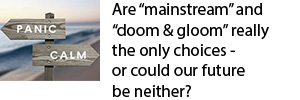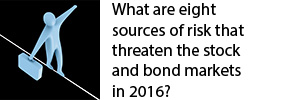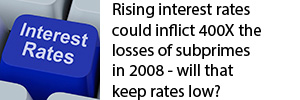Yellen's Tiger Riding Dilemma Keeps Interest Rates Near Zero
by Daniel R. Amerman, CFA
Riding a tiger is one thing. But getting off the tiger, without that tiger then whirling around and consuming you – now that is another thing altogether.
A short non-econospeak translation of the results of the March 17-18 Federal Reserve meeting is that Fed chairwoman Janet Yellen still maintains that she is getting off that tiger – someday – but not at this moment because she doesn't know how to keep the US economy and markets from being eaten in the process.
The United States has been "riding the tiger" for some years now in the aftermath of the 2008 crisis, relying on "unconventional monetary policies" which boil down to creating trillions of dollars out of the nothingness and forcing interest rates to near zero. The reason for doing this has been to attempt to contain the economic and financial damage, even while creating an illusion of sorts for the nation as a whole by putting a soft cocoon around markets.
Record sums of cheap money flooding into the markets have driven bond markets and stock markets to historic highs. This has little to do with any of the usual underlying fundamentals, but rather it is the artificial creation of cheap money on a fantastic scale that has enabled this whole process.
In the immediate aftermath of the Fed announcement, stock markets soared, and bonds jumped as yields declined, even as the dollar plunged against other major currencies. All three are closely interrelated, and all three are based on the same thing. The Fed expressing concern about slower than expected economic growth was interpreted to mean that there likely wouldn't be a June increase in interest rates after all. Indeed, as reported in Bloomberg, per their mathematical interpretations of the moves in futures prices, the market shifted the most likely date for a small increase in US interest rates from June to December.
So, six more months of artificial cheap money supporting stock markets prices and bond prices.
Even more importantly – six more months without a soaring dollar crippling US exports and increasing unemployment. "The tiger" is thus kept at bay for another six months.
The mainstream narrative is that everything is just great with the markets and the economy, and things are moving back to "normality". If that were actually true, however, interest rates would already be rising, and there would be no deferrals. Instead, we continue to have economies and markets that have become addicted to extraordinary governmental interventions. Withdrawing these interventions is what would force a "truth test" on the markets – with results that the Fed clearly still fears deeply when it comes to taking actual actions instead of merely making speeches.
Understanding The Tiger That May Eat Markets & Economies
There are multiple reasons for why the United States government engaged in quantitative easing for so many years, and why interest rates were driven so low. As I have previously written about extensively, one of the primary reasons is that the United States has been one of the participants in a global game of currency warfare.
And for most of the world this currency warfare is not only still ongoing, but has been shifting into another gear altogether, which is producing substantially positive results for the nations involved.
As covered in this recent news article, the relentless war Japan has been waging against the value of the yen continues to generate increases in exports.
By driving down the value of the yen, Japanese workers, companies and products have become cheaper to the rest of the world, giving Japan a competitive advantage – and this has been rebooting Japanese economic growth.
Simultaneously, Europe has begun its own relentless campaign against the value of the euro, driving it to the lowest level seen in more than 11 years against the US dollar. And the weapon of choice it has been talking about – and is now finally introducing – is a massive European program of quantitative easing / monetary creation.
And as covered in this Chinese news story we're already seeing a major change in competitiveness with European workers versus Chinese workers.
The Chinese are losing the advantage they've had for decades against the Europeans, and there's a good chance that European companies and workers will feel the very positive effects of a much weaker euro – unless the Chinese counterattack with another assault on the value of their own currency.
So in a world in which countries are competitively assaulting the value of their own currencies, and slashing interest rates for their own investors and their own retirees, the United States is talking about "decoupling", and unilaterally dismounting the tiger so to speak.
Now in an internationally interlinked world, with markets being held up by extremely cheap money, just how to do this is an incredibly difficult question.
Because the danger is that a 1-2 crisis scenario is set off.
The first element is the fundamental economy. The US raising interest rates, which (all else being equal) increases the value of the nation's currency, at the very same time when every other major economic power in the world is attempting to cut the value of their own currencies, could be called unilateral surrender.
It means that US workers are almost certain to suddenly be under an extraordinary competitive disadvantage when it comes to Japanese workers, European workers and Chinese workers.
Simultaneously, the very cheap money which has been driving US stock markets is being withdrawn.
So the market support crumbles, even while the economic growth that the stock market is based upon is savaged.
Falling economic growth – or no economic growth, or perhaps even a shrinking real economy – combined with the removal of the artificial supports that stock market prices are based upon is a powerful two-part recipe for the rapid destruction of stock market values.
That's the danger, and that's why for some years now in their more candid moments, Federal Reserve economists have been admitting they're not exactly sure how an exit strategy is going to work. For "decoupling" and unilaterally exiting the tiger potentially creates simultaneous economic damage and market damage.
And what we see happening in practice is that there does not appear to be any preplanned exit strategy or contingency plans for how to exit this impossible situation unscathed. The Fed says they want to exit – but clearly, they still lack the specifics for what to do next when that tiger quite predictably whirls around toward them with open jaws.
So they defer. Repeatedly.
Huge Risks For Miniscule Gains
Unfortunately, there has been an ongoing powerful cost to these "unconventional monetary policies" that have helped maintain stability (even if artificial) in the US financial markets.
Which is that this artificial stability has been achieved by essentially sacrificing the retirement income of current retirees on a deliberate basis, with the long term creation of retirement wealth having been slashed by as much as 95% for many retirement investors, even as the current standard of living for many current retirees has been reduced by close to 50%.
Indeed, government policies have essentially pulled the rug out from underneath conventional retirement planning and turned long-term investment from being a process of wealth creation to a process of wealth destruction for many millions of savers and investors.
Given this situation, one might therefore be encouraged by the Fed's discussion of increasing interest rates.
The problem however is that the increases being considered are quite small, perhaps somewhere in the 0.25% to 1.00% range – which unfortunately is going to make very little difference when it comes to retirement income.
An increase from let's say 0% to 1% has only a very minor impact on long-term investment profits. On the other hand, increasing yields to more like 4%, 5%, 6% (in other words something closer to historical averages) has a hugely positive impact on the creation of wealth, as well as the quality of life that a given portfolio will support in retirement.
The issue has been that because the United States is now $18 trillion in debt, increasing interest rates to more historically-average levels could set off an explosive compounding of the size of the annual US deficit as well as the total amount of US debt outstanding.
So it should therefore be anticipated that any interest-rate increases are likely to be quite small. Which unfortunately leaves conventional investors in a lose-lose situation.
The first level of loss is a fundamental weakening of the US economy, as that brings everything downward.
If the real wealth of goods and services isn't being created, then the wealth isn't there for the nation to consume, and the rest is merely paper gains and the redistribution of wealth. The wealth isn't there for investments, and it also isn't there for Social Security and Medicare.
Simultaneously, even as the real economy and jobs are savaged, the artificial support mechanisms are removed, creating a danger of swift and major downward movements in equity market prices.
Now while this might be a worthwhile risk if we could genuinely reboot long-term investment performance, if realistically all that we can afford given the current national debt and other constraints is a fairly small increase in interest rates, then the small increase in retirement investment income and retirement lifestyle is quite minor in comparison to the potential economic damage that is being done to the nation as a whole.
Actions Speak Louder
A fundamental conflict remains between reality, and what we are told reality is as part of the mainstream investment narrative. Let me suggest that those who do not take this conflict into account risk repeated financial surprises, some of which may be quite unpleasant. If the US markets and economy are actually as strong as we are told on a daily basis – then there is no reason whatsoever for the government to be forcing near zero interest rates.
Across America and around the world, retirees and long term investors are paying a very real price for the continuation of "unconventional" central banking interventions on a massive scale. Interest rates being forced below the rate of inflation on a quite deliberate basis translates to the personal cost of retirees forced to make difficult daily choices when it comes to food, clothing and other components of their daily standard of living, because what they assumed would be interest earnings in retirement – have not materialized.
Lower retirement account income also translates to delays in planned retirement dates for many other millions of people. Even as pension funds remain underfunded because of very low interest yields, thereby placing retirement benefit payments at risk.
Healthy economies and markets don't need the indefinite continuation of the unprecedented and the fantastic. Period. This is no more than common sense, and serves as a basic "truth test". The proclamation that there has been a return to healthy normality, even while interest rate returns from retirees and others continue to be artificially stripped on an indefinite basis – creates an absolute conflict between words and actions.
I do strongly believe that there are answers, and that the current environment creates as many opportunities as it does dangers. The first step is to recognize that the financial world is a different place than it used to be, and that those continuing to follow the usual investment advice are unnecessarily exposing themselves to extraordinary risks without a compensating upside potential.
 What you have just read is an "eye-opener" about one aspect of the often hidden redistributions of wealth that go on all around us, every day.
What you have just read is an "eye-opener" about one aspect of the often hidden redistributions of wealth that go on all around us, every day.
 A personal retirement "eye-opener" linked here shows how the government's actions to reduce interest payments on the national debt can reduce retirement investment wealth accumulation by 95% over thirty years, and how the government is reducing standards of living for those already retired by almost 50%.
A personal retirement "eye-opener" linked here shows how the government's actions to reduce interest payments on the national debt can reduce retirement investment wealth accumulation by 95% over thirty years, and how the government is reducing standards of living for those already retired by almost 50%.
 An "eye-opener" tutorial of a quite different kind is linked here, and it shows how governments use inflation and the tax code to take wealth from unknowing precious metals investors, so that the higher inflation goes, and the higher precious metals prices climb - the more of the investor's net worth ends up with the government.
An "eye-opener" tutorial of a quite different kind is linked here, and it shows how governments use inflation and the tax code to take wealth from unknowing precious metals investors, so that the higher inflation goes, and the higher precious metals prices climb - the more of the investor's net worth ends up with the government.
 Another "eye-opener" tutorial is linked here, and it shows how governments can use the 1-2 combination of their control over both interest rates and inflation to take wealth from unsuspecting private savers in order to pay down massive public debts.
Another "eye-opener" tutorial is linked here, and it shows how governments can use the 1-2 combination of their control over both interest rates and inflation to take wealth from unsuspecting private savers in order to pay down massive public debts.






If you find these "eye-openers" to be interesting and useful, there is an entire free book of them available here, including many that are only in the book. The advantage to the book is that the tutorials can build on each other, so that in combination we can find ways of defending ourselves, and even learn how to position ourselves to benefit from the hidden redistributions of wealth.


















